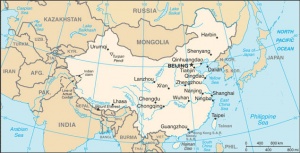China Statistics
| Embryology - 27 Apr 2024 |
|---|
| Google Translate - select your language from the list shown below (this will open a new external page) |
|
العربية | català | 中文 | 中國傳統的 | français | Deutsche | עִברִית | हिंदी | bahasa Indonesia | italiano | 日本語 | 한국어 | မြန်မာ | Pilipino | Polskie | português | ਪੰਜਾਬੀ ਦੇ | Română | русский | Español | Swahili | Svensk | ไทย | Türkçe | اردو | ייִדיש | Tiếng Việt These external translations are automated and may not be accurate. (More? About Translations) |
Introduction
This page links to the current online resources available to explore Chinese population, birth data and embryology related topics. Chinese birth rate is 12.3 births/1,000 population (2017 est.).
| Statistics Links: Introduction | Reports | World Population | World Fertility | World Infant Mortality | Maternal Mortality | Australia | Brazil | Canada | China | Germany | India | Indonesia | Europe | Myanmar | Netherlands | Spain | United Kingdom | Romania | Uganda | United States | BGD Tutorial - Applied Embryology and Teratology | National Perinatal Statistics Unit | AIHW | Category:Statistics | |
|
Some Recent Findings
|
| Older papers |
|---|
| These papers originally appeared in the Some Recent Findings table, but as that list grew in length have now been shuffled down to this collapsible table.
See also the Discussion Page for other references listed by year and References on this current page.
|
Birth
- At the end of 2009, the total number of Chinese population reached 1,334.74 million, an increase of 6.72 million over that at the end of 2008. The year 2009 saw 16.15 million births, a crude birth rate of 12.13 per thousand, and 9.43 million deaths, or a crude death rate of 7.08 per thousand. The natural growth rate was 5.05 per thousand. The sex ratio at birth was 119.45.[6]
- At the end of 2008, the total number of Chinese population reached 1,328.02 million, an increase of 6.73 million over that at the end of 2007. The year 2008 saw 16.08 million births, a crude birth rate of 12.14 per thousand, and 9.35 million deaths, or a crude death rate of 7.06 per thousand. The natural growth rate was 5.08 per thousand. The sex ratio at birth was 120.56.[7]
- At the end of 2007, the total number of Chinese population reached 1,321.29 million, an increase of 6.81 million over that at the end of 2006. The year 2007 saw 15.94 million births, a crude birth rate of 12.10 per thousand, and 9.13 million deaths, or a crude death rate of 6.93 per thousand. The natural growth rate was 5.17 per thousand. the sex ratio at birth was 120.22.[8]
| More recent papers |
|---|
|
This table allows an automated computer search of the external PubMed database using the listed "Search term" text link.
More? References | Discussion Page | Journal Searches | 2019 References | 2020 References Search term: China Embryology <pubmed limit=5>China Embryology</pubmed> |
Nutrition
- 3% of infants with low birthweight, 2005-2009
- 96% of households consuming iodized salt, 2003-2009
- Unknown Vitamin A supplementation coverage rate (6-59 months) 2009
- Data: UNICEF
General Statistics
Population 1,336,718,015 (July 2011 est.) country comparison to the world: 1
Age structure
- 0-14 years: 17.6% (male 126,634,384/female 108,463,142)
- 15-64 years: 73.6% (male 505,326,577/female 477,953,883)
- 65 years and over: 8.9% (male 56,823,028/female 61,517,001) (2011 est.)
Median age
- total: 35.5 years
- male: 34.9 years
- female: 36.2 years (2011 est.)
Population growth rate
- 0.493% (2011 est.)
- country comparison to the world: 152
Birth rate
- 12.29 births/1,000 population (2011 est.)
- country comparison to the world: 160
Death rate
- 7.03 deaths/1,000 population (July 2011 est.)
- country comparison to the world: 132
Sex ratio
- at birth: 1.133 male(s)/female
- under 15 years: 1.17 male(s)/female
- 15-64 years: 1.06 male(s)/female
- 65 years and over: 0.93 male(s)/female
- total population: 1.06 male(s)/female (2011 est.)
Infant mortality rate
- total: 16.06 deaths/1,000 live births
- country comparison to the world: 112
- male: 15.61 deaths/1,000 live births
- female: 16.57 deaths/1,000 live births (2011 est.)
Life expectancy at birth
- total population: 74.68 years
- country comparison to the world: 95
- male: 72.68 years
- female: 76.94 years (2011 est.)
Total fertility rate
- 1.54 children born/woman (2011 est.)
- country comparison to the world: 182
HIV/AIDS
- 0.1% (2009 est.)
- country comparison to the world: 122
Major infectious diseases
- degree of risk: intermediate
- food or waterborne diseases: bacterial diarrhea, hepatitis A, and typhoid fever
- vectorborne diseases: Japanese encephalitis and dengue fever
- soil contact disease: hantaviral hemorrhagic fever with renal syndrome (HFRS)
- animal contact disease: rabies
- highly pathogenic H5N1 avian influenza has been identified in this country
- Data: The World Factbook China
Abnormalities
Maternal and congenital syphilis
The following information is from a recent study of maternal and congenital syphilis in Shanghai, China, 2002 to 2006.[9] That has identified a resurgence of congenital syphilis, especially in the migrating population and other populations with a lower socioeconomic status.
- A total of 535,537 pregnant women were included in the analysis.
- 1471 maternal syphilis cases (298.7 per 100 000 live births) identified.
- 334 congenital syphilis cases (62.4 per 100,000 live births) identified.
- Both maternal and congenital syphilis rates increased from 2002 until 2005, with a slight decrease in 2006.
- The rate of maternal syphilis was:
- 156.2 per 100,000 live births in Shanghai residents.
- 371.7 per 100,000 live births in the migrating population (p<0.001).
- The compliance to treatment for maternal syphilis was poorer in women with a lower level of education.
- The rate of congenital syphilis in infants born to mothers with incomplete treatment (50.8%) was much higher than in infants born to mothers with complete treatment (12.5%).
- complete treatment group - rates of fetal death (5.5%), neonatal death (0.56%), and major birth defects (0.46%)
- incomplete treatment group - rates of fetal death (30.4%), neonatal death (11.0%), and major birth defects (3.8%)
- Infant outcome affected by initial maternal RPR antibody level and time of treatment
- much better outcomes in mothers with low antibody levels and earlier treatment.
Historic Embryology
Tong Dizhou
(童第周) Ti Chou Tung (1902 - 1979)
- "Tong learned from famous European embryologists when studying in Belgium, published several papers after careful observation and researches, which exerted great effects on the biological field of Europe at that time. He made systematic studies of sea squirts and amphibiology, especially the growth of fish ovum. He put forth the idiographic idea that fish ovum does not have the equal growth ability in the budding period. He also made breakthroughs in the biological study and researches, found new ways to control fish's hereditary variation." (Ministry of Culture, P.R.China)
References
- ↑ Li A, Zhuang T, Shi J, Liang Y & Song M. (2019). Heavy metals in maternal and cord blood in Beijing and their efficiency of placental transfer. J Environ Sci (China) , 80, 99-106. PMID: 30952357 DOI.
- ↑ Liu C, Li Q, Yan L, Wang H, Yu J, Tang J, Yao H, Li S, Zhang Y & Guo Y. (2019). The association between maternal exposure to ambient particulate matter of 2.5 μm or less during pregnancy and fetal congenital anomalies in Yinchuan, China: A population-based cohort study. Environ Int , 122, 316-321. PMID: 30455103 DOI.
- ↑ Liu W, Huang C, Cai J, Wang X, Zou Z & Sun C. (2018). Household environmental exposures during gestation and birth outcomes: A cross-sectional study in Shanghai, China. Sci. Total Environ. , 615, 1110-1118. PMID: 29751416 DOI.
- ↑ 4.0 4.1 Yuan W, Sipp D, Wang ZZ, Deng H, Pei D, Zhou Q & Cheng T. (2012). Stem cell science on the rise in China. Cell Stem Cell , 10, 12-5. PMID: 22226351 DOI.
- ↑ 5.0 5.1 Oestergaard MZ, Inoue M, Yoshida S, Mahanani WR, Gore FM, Cousens S, Lawn JE & Mathers CD. (2011). Neonatal mortality levels for 193 countries in 2009 with trends since 1990: a systematic analysis of progress, projections, and priorities. PLoS Med. , 8, e1001080. PMID: 21918640 DOI.
- ↑ National Bureau of Statistics of China (2010) Statistical Communiqué of the People's Republic of China on the 2009 National Economic and Social Development
- ↑ National Bureau of Statistics of China (2009) Statistical Communiqué of the People's Republic of China on the 2008 National Economic and Social Development
- ↑ National Bureau of Statistics of China (2008) Statistical Communiqué of the People's Republic of China on the 2007 National Economic and Social Development
- ↑ <pubmed>20137991</pubmed>
External Links
External Links Notice - The dynamic nature of the internet may mean that some of these listed links may no longer function. If the link no longer works search the web with the link text or name. Links to any external commercial sites are provided for information purposes only and should never be considered an endorsement. UNSW Embryology is provided as an educational resource with no clinical information or commercial affiliation.
- Chinese Government National Bureau of Statistics of China | Statistical Communiqué of the People's Republic of China on the 2009 National Economic and Social Development (2010)
- UNICEF China Statistics
- The World Factbook China
- Tong Dizhou - Open Library - Tong Dizhou (Published 1989 by Xin hua shu dian Beijing fa xing suo fa xing, Written in Mandarin)
Ministry of Culture, P.R.China | Wikipedia
Glossary Links
- Glossary: A | B | C | D | E | F | G | H | I | J | K | L | M | N | O | P | Q | R | S | T | U | V | W | X | Y | Z | Numbers | Symbols | Term Link
Cite this page: Hill, M.A. (2024, April 27) Embryology China Statistics. Retrieved from https://embryology.med.unsw.edu.au/embryology/index.php/China_Statistics
- © Dr Mark Hill 2024, UNSW Embryology ISBN: 978 0 7334 2609 4 - UNSW CRICOS Provider Code No. 00098G



